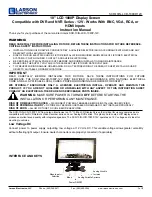
Operating the projector
Mirage M Series User Manual
69
020-101942-02 Rev. 1 (10-2018)
•
Constant Power
mode maintains a specific power level for the lamp. The power level can be
adjusted with the
Power
controls (see below).
Specifying the amount of power sent to the lamp
The
Lamp
>
Power
control represents the amount of power sent to the lamp(s) in Watts. Lower
power levels reduce brightness and extend lamp life. This control is only enabled while in Constant
Power mode.
This slide bar does not update in real-time when operating in Maximum Brightness or Constant
Intensity mode. To see the amount of power being applied to the lamp while in Maximum Brightness
or Constant Intensity, see the Lamp Info page on the Status tab of the web interface.
Setting the target brightness
The intensity control represents the target brightness for the LiteLOC system. The value at
Lamp
>
Intensity
is a percentage of the maximum brightness of the lamp(s). This control is only enabled
while in Constant Intensity mode.
Configuring lamp failover
Enabling the
Lamp
>
Single Lamp Switch on Fail
option causes the projector to automatically
turn on the other lamp, should the currently operating lamp turn off during normal operation or if
the currently selected lamp fails to ignite.
This control is only in effect while in the following modes:
• Lamp 1 single lamp use
• Lamp 2 single lamp use
• Auto-select a single lamp
A brief period of no light occurs before the other lamp ignites and warms up sufficiently. The
operational mode of the projector may change from Lamp 1 single lamp use to Lamp 2 single lamp
use or visa versa with the option enabled. For example: If lamp 1 fails to ignite and lamp 2 ignites
successfully, then the operational mode changes to Lamp 2 single lamp use. This option does not
change the operational mode if it is set to
Auto-select a single lamp
.
Using multiple projectors
When working with more than two projectors, work left to right, top to bottom.
When an installation requires multiple projectors, use the RS232 serial ports to daisy chain the
units together and control the group with a single keypad or a computer/controller connected to the
first projector. In such a network, you can choose to broadcast commands to the entire group, or
use the
Proj
key as required to limit responses to an individual projector.
Alternatively, you may want to add projectors to a hub on an Ethernet network. See
on page 39 for full routing details.
Tiling an image over multiple screens
Image tiling allows a single input image to be displayed, spread over multiple screens, with each
screen displaying a fraction of the image. The image is displayed by the
m × n
array of projectors,
http://www.pureglare.com.au
















































